Xtreme Vogue Mumbai Desk: Komal Qureshi
Interview by Vanya Lochan. Photographs by Anish. Styled by Susan Thomas. Assisted by Aakriti Arora. All clothing and accessories, Susan’s own. Location courtesy: NIFT Bengaluru.
“From my home, I would travel 125 kilometres every day to reach my office…sometimes battling the heat of 50 plus, considering that it’s Rajasthan and in winter, across lush fields of mustard, almost what you see in all the Bollywood movies. But not a man in sight, not a woman in sight, not an animal in sight. That’s precisely what the government does and where the government functions.” I watch as Susan Thomas, who has been working with the Indian Revenue Services for more than 21 years now, tries to tell us “why working in the government is lit”. She continues matter-of-factly: “We love to hate all that is from the government, and we love to hate the sarkaari babu.”
As someone who had disowned a long-lived dream of joining the government out of utter disillusionment and college-learnt dismay towards, as my peers and I saw it, “the colonial, feudal institution of bureaucracy”, I follow the administrator’s 2020 TEDx talk half-sceptical, half-irresolute.
“When [the students’] parents come to see me, as they walk into the room, they expect to see a man — they expect to see an old and greying man, and then they expect to see a professor.” I pause the video and enter a search for “Susan Thomas IRS” to find her Instagram account, and I meet @afsarnama, or “chronicles of an officer”. Now, I’m intrigued. I scroll through various vignettes — photos of her in radiant peach kosa saris, kalamkari blouses, embroidered tussar and golden muga, followed by detailed captions describing the rich history of the textiles and the sheer beauty of their variety.
The 44-year-old Thomas’ reels are all set to social media’s trending formats and sounds as she looks to educate and engage her followers on a range of topics like how chikankari and hakoba are not the same thing, the faux pas in Gangubai Kathiawadi’s period wardrobe design or how ikat, with its calculated warp and weft dye, an example of applied mathematics. Over a Zoom call with her, I discover an unexpected bond over a mutual love of modern Indian history, subaltern studies, Instagram and what Foucault or Fanon can tell us about fashion. With her right knuckle placed carefully under her chin, she routinely smiles as she takes me through various eras across the history of India — not flinching even when I raise tougher questions such as the implications of our so-called sustainable practices on factory workers and artisans or when I badger her about her blouse tailors and the many saris in her wardrobe. She answers thoughtfully, and the twinkle in her eyes never fades.
Susan Thomas is not just a bureaucrat: she is a storyteller, an educator and a fashion philosopher — one of the few who are talking extensively about the many faces of Indian fashion in a way that the upholders of the industry rarely do.
In Verve’s attempt to consider alternative ways of thinking about fashion and our relationship to what we wear, Thomas directs our eyes away from the sparkly bits and shows us how intimately interwoven our everyday lives and fashion truly are.
Edited excerpts from the interview:
What does an administrator have to do with fashion?
I get asked this a lot, so let’s start with the history of NIFT [National Institute of Fashion Technology]. It was established in 1986 by the government — a rare and dynamic feat for a young resource-strapped country that was just learning to walk on its own two feet. Despite everything, it was ambitious enough to start a fashion education institution to cater to the demands of an equally young garment manufacturing and exporting industry and make professional education, like design, accessible to all. The government joined hands with FIT [Fashion Institute of Technology], New York, and it was the AEPC [Apparel Export Promotion Council] that gave it a fillip. And, starting out as part of the Ministry of Textiles [Thomas has been working with them since 2018 — her current position is part of her deputation to Textiles], we were at a very unique intersection. NIFT has never been just about the narrow definition of fashion that we associate it with — it’s not only about garments. It is also about handlooms and handicrafts, which form the backbone of our export industry, not to mention hold emotional and historical value. And so, NIFT has always positioned itself very robustly with the craft clusters. I think that’s why the administration always rested with government servants — the first executive director was Rathi Vinay Jha, an IAS officer. Campus directors were, again, part of the government machinery. We are probably the only educational institution that is located within a government structure and imparts fashion and design education. Unlike private design institutes, NIFT’s student profile is pan-Indian and cuts across classes. This is why administrators from the government are important; we have reach where nobody else does.
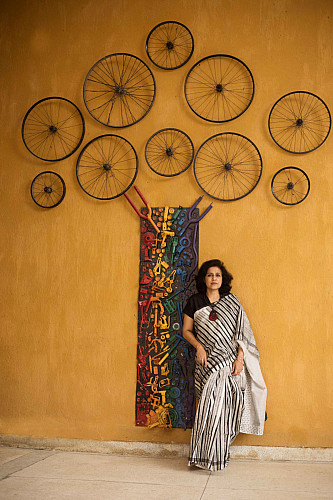
Why did you pick NIFT, when you could have gone to any of the IITs or IIMs or even the much-coveted LBSNAA [Lal Bahadur Shastri National Academy of Administration] in Mussoorie? Is it because you were interested in fashion? Or was it about handicrafts?
At some point in the ’90s, I seriously toyed with the idea of pursuing an education with NIFT. I’ve always had a very keen interest in fashion in terms of its definition as a form of cultural expression, and how it becomes an expression of a community’s imagination more than anything else, rather than ramp fashion or designer wear, so to speak. I’m a history student, and I’ve studied modern Indian history with a lot of cultural studies thrown in. So, with the ways and the fashion of the times, a certain motif becomes important; all these things have reflection and are a reflection of the political and the economic, along with a mix of other things.
After coming back from my study leave at Oxford [Thomas completed a master’s from the Blavatnik School of Government in 2016], I somehow had the energy to go back to an educational institution. NIFT seemed to encapsulate all of my likings — I was fascinated by its vision. Of course, the added benefit was that it was located in Bangalore, so I didn’t have to move cities; it was just a very easy choice for me to walk into NIFT, and then everything else sort of fell into place. I am working with income tax, so I eventually have to go back to finance. Finance to textiles and fashion is definitely a shift and my time at NIFT is a brief sojourn; however the opportunity to advance my knowledge about textiles while situating it within an academic framework, as also to learn about a completely new field, is exciting and enriching in more ways than one. NIFT has opened my eyes to a lot of things. One is the way that Gen Z and millennials are thinking and the work culture that we are increasingly moving towards. And, second, the wealth of this country — handlooms and handicrafts, the way textiles have exploded even into the medical and technical worlds in a post-pandemic world. Fashion institutes have only just started to study the tip of the huge iceberg, and I am glad to be a part of this movement.
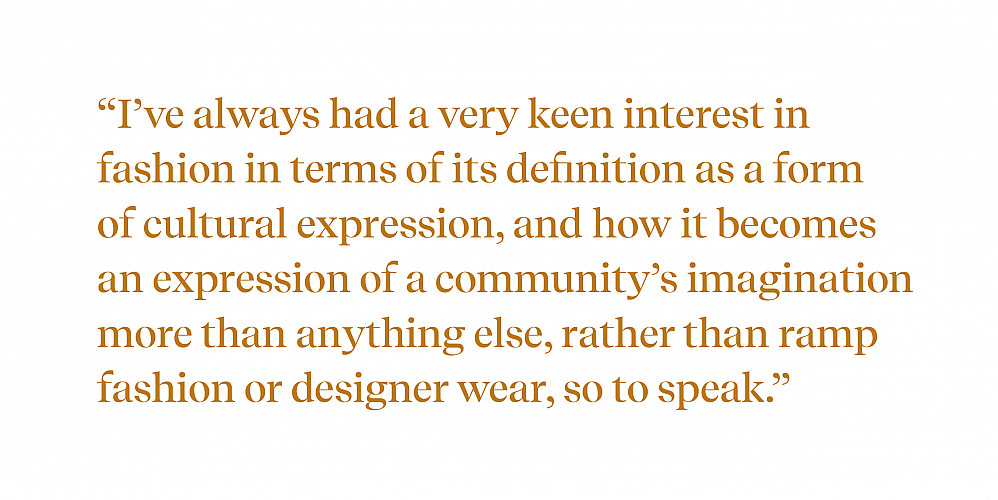
I think what we’re getting at is that there isn’t a very clear definition of what fashion can entail, right? I assume it’s not the same as style, and it also goes beyond just clothes. So, I want to ask, how would you define fashion?
Historically speaking, the royals were the “fashionable” ones because they had the access and the resources. However, there have also been movements where we have tried to write about subaltern fashion in the same way that we write about subaltern history. At JNU [Jawaharlal Nehru University], where I read my master’s in modern Indian history, one of our pet topics was subaltern history — we need to move away from the stories of kings and queens and talk about what the farmer or the merchant on the street did. Clothing is the first and the most important means of non-verbal communication, and, as a cultural expression, it operates on multiple levels just like everything else, be it economics or politics. We cannot pretend that we are immune to global trends, especially now, when borders are pretty transparent and we are all travelling — both physically and digitally — and have access to what’s being worn around the world. So, what somebody is wearing on the red carpet might have an effect in a small town. As consumers, we are also perpetrators: we generate fashion. Since we are social animals, we believe in mimicry, and mimicry creates trends.
Could you tell me more about the impact of sustainability and slow fashion movements on the makers of clothes? If I buy less and repurpose everything, would a garment worker, who would otherwise have earned money to produce clothes, get paid less? If my consumption patterns mean a loss of livelihood for someone else, do I still get to say that I am sustainable?
Let’s define sustainability first — it’s about the practices that the wearer makes, such as not ordering too much and repurposing their purchases. Sustainability can also mean, maybe, limiting myself to natural dyes or not using synthetic materials. So, what is the impact these fancy terms have on the workers, the artisans, the makers? Unfortunately, when we talk about sustainability today, we are only concentrating on the production processes. For instance, buying clothing made from natural fibres might be sustainable, but the point is lost if you’re going to be buying hundreds of these on a monthly basis without repeating the garments or getting into a mindful consumption pattern. The generation that is reaping the benefits of liberalised, globalised India by being in its workforce — the urban elite — has a lot of disposable income, unlike the previous generations for whom new clothes were reserved for festivals, birthdays, anniversaries and other special occasions. Now, shopping is an everyday, every-minute affair, so we are accumulating a lot more than what we need. Neuromarketing makes sure that you’re perpetually shopping. It then becomes very difficult to swim against the tide and be consciously aware of how much bang for your buck you’re going to get.
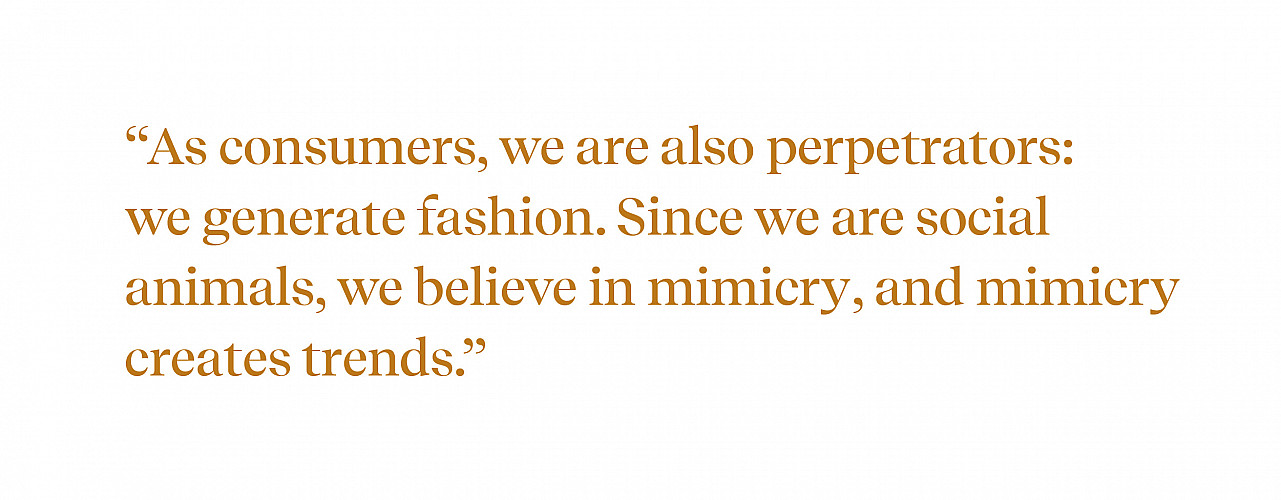
India has had a culture of repurposing textiles brilliantly, but I think it was the necessity of a globalised world to open up to brands. Once the brands enter, and you have season sales, and when there are high net-worth individuals who travel a lot and have disposable income, then clothing is no longer just a necessity.
In terms of sustainability affecting workers, you must first realise that factory work has become a forced necessity. Workers can migrate to other fields and small businesses, and that’s where the support must be provided to them — but we also need to consider who we are benefiting by buying more, the workers or the multimillionaire multinationals? I would probably restrict the “buy more to support” logic to helping artisans in small haats [local rural markets] and consequently the local economy. Choosing to buy vegetables from local farmers or Diwali decor from local potters not only helps the economy and supports their livelihoods but also reduces one’s carbon footprint.
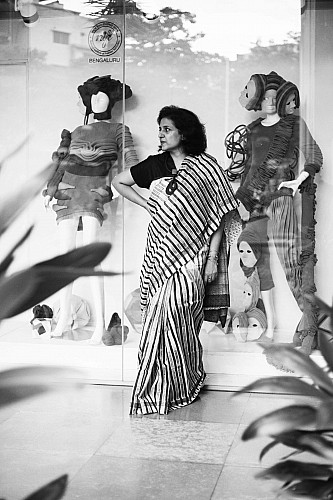
You are a lover of saris. How long have you been fascinated with the garment? And what first got you interested in textiles?
I’ve been fascinated with saris ever since I can remember. My earliest trips were to Handloom House with my mother, and Handloom Houses, if you recall, were the outlets of the All India Handloom Board, and they used to stock a fairly good representation of handlooms from across the country. I can remember myself as a kid of six or seven talking to the salesmen in these shops and how they would indulge me and answer my questions in detail.
Did you ever raid your mother’s or grandmother’s closets? Also, what did you wear to JNU? As a Delhi University student, I was always in my kurta, jeans and chappals. Did you dress similarly in college, or had you already developed a love for saris?
I used to wear saris to college only during ceremonies because I was a member of the student council. My grandmother only wore all-white and was not a sari person. I belong to the Syrian Christian community, and we wear the chatta, mundu and neriyathu — it is a three-piece garment. My mother did wear saris, however, and that’s how I learnt to wear them. Hers and my aunts’ kanchipurams were the first ones I tried, and then there were cotton saris. JNU was an interesting sartorial experiment. Winters were spent mostly in jeans and tees. Of course, it helped that Delhi is also the mecca of manufacturing surplus, and then you had Sarojini Nagar, which is quite friendly to student budgets. Summers were definitely in salwar kurtas. I don’t think I wore a sari casually even once in JNU.
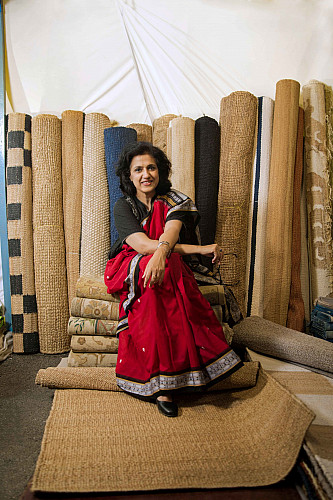
What do you think the future holds for the sari? Does it need another interpretation? Why is it important to “save the sari”?
I completely disagree that the sari needs to be “saved” because a huge percentage of the population still wears them to work in. I see BBMP [Bruhat Bengaluru Mahanagara Palike] workers in the mornings wearing saris. Our housekeeping ladies at NIFT wear saris too. Maybe they’re wearing georgettes or synthetic fabrics, but the garment is definitely here to stay. So, “saving the sari” is a very uppity, snobbish way of looking at it because it just doesn’t need to be saved. I also think the sari does not need any reinterpretation because it’s one of the longest unstitched garments, and each person can own the sari in his or her own way. So, you could, say, drape it once in the Nivi style or the seedha palla [wherein the loose end is draped over the right shoulder back to front] or, maybe, wear it like a skirt or a sarong! In fact, the present generation is probably a lot more open to drape experimentation, and that’s a good sign.
What is your favourite type of sari?
It would be simple mull cotton in basic colours because then the options for styling, like the blouse variations, are infinite. Coming from an extremely organised sector like the Civil Services, I almost always wear the Nivi drape to the office, and it’s only after coming to NIFT that I have loosened up a little and become a bit more experimental, say, by wearing crop tops or kurtis as blouses.
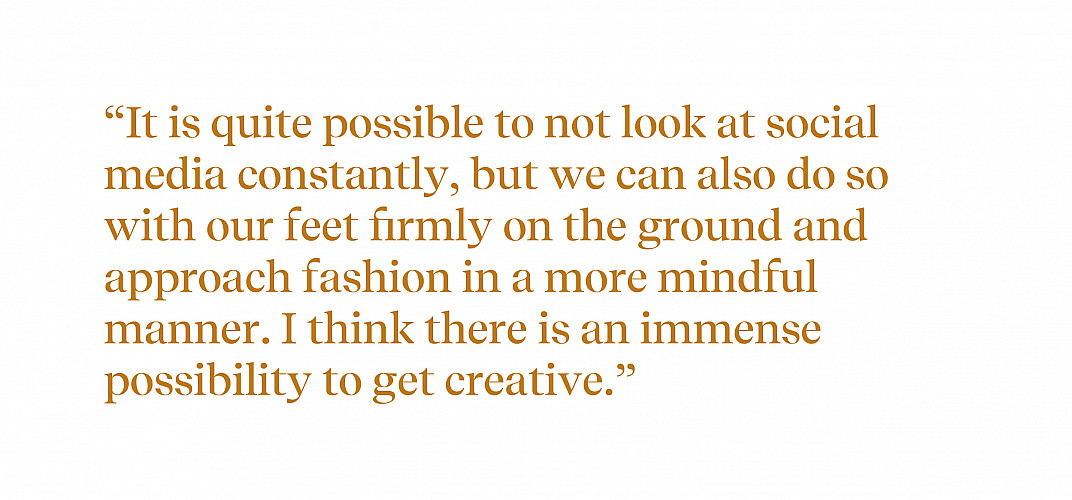
I am constantly fascinated by your minimalist accessorising as well. Take me through your styling process.
My styling process in the office is very conservative. In a typical government office, it’s very difficult to find people who wear heavy accessories, but there are occasions when I do wear chunkier pieces. I really like to keep it minimal and functional because if I were to wear chunky bracelets and bangles, I would struggle with handling files and so on. So, unless an occasion demands otherwise, I like to keep it very, very simple for the sake of functionality.
What is the consensus among students in the current NIFT batches towards sustainability?
Fortunately, there is a fairly robust and solid consensus that sustainability has to be about a much more mindful consumption pattern than anything else. The students go for smaller brands, and thrifting is a major practice. We encourage clothing exchanges on NIFT campuses; we have regular drives for swaps and trunk sales. Our fashion students are acutely aware of the processes, and there is definitely an impetus to create more garments with sustainable materials and support conscious consumption, natural dyeing processes, zero-waste patterns, etc.
You had put up a post on how Indian brides follow a certain aesthetic template. I am afraid that most women do the same thing on a daily basis — we all have that one indie dress (a Jodi or a Chidiyaa), the same Zara trousers, and, of course, “tap to view/shop” only means that emulation is possible, easily available and perpetually encouraged. How, in your opinion, has Instagram changed our philosophy of fashion? Can we avoid looking like everyone else on social media?
What I lament the most about bridalwear following a template is the homogeneity being assumed — the loss of local stories and communities from the fashion map. For example, a typical Kerala bride who would otherwise wear either a cream-and-white or white-and-gold sari with traditional jewellery might be giving way to Banarasi and polki. It is well-nigh possible to not follow trends as much as it is to follow them at all times. We are not the same person through the day or through the week, which means that our work wardrobes could carry the latest trends but our evening wear could be something entirely different — perhaps a beautiful dress made of a local handmade khana fabric, which we could pair with handcrafted silver jewellery. It is quite possible to not look at social media constantly, but we can also do so with our feet firmly on the ground and approach fashion in a more mindful manner. I think there is an immense possibility to get creative!
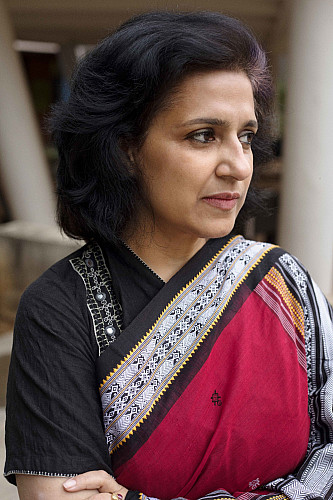
What is our relationship with the history of fashion in India? How can publications and the media do justice to this heritage?
Unfortunately, one seldom sees the history of Indian textiles in fashion editorials. A conversation about silhouette without a discussion on the fabric or yarn is bound to be reductionist and lopsided. That is something that I would really like fashion writing to pick up on — to connect the dots, to talk about motifs and history, to talk about how culture has travelled from one continent to another. Fashion has always fomented a certain possession craze. Fashion writing needs to inform us that liking something doesn’t necessarily mean having to possess it. I know it goes against the commercials because revenue relies on advertising, but if at all we could decide on a certain portion of our stories to be about heirlooms, passing on traditions, about investing and buying consciously, and also, personal stories, then we might be looking at a new kind of philosophy of fashion. And if you take Instagram — which didn’t matter or influence my own choices to a large extent because I only took to it in my 40s — the fashion community there is guilty not only of propelling the industry towards increased consumption without a mindful understanding of whether one really needs so much but also of buckling to trends. They should correct that course.


